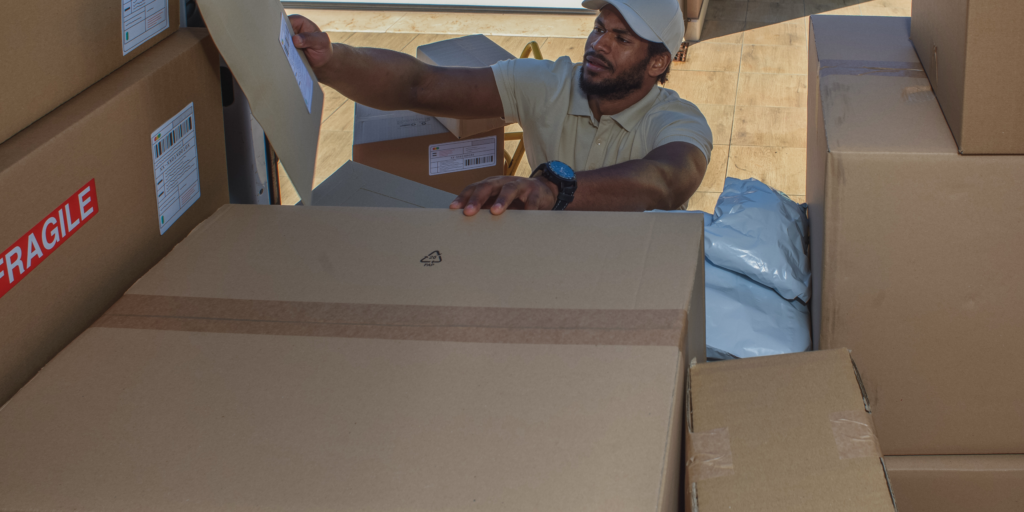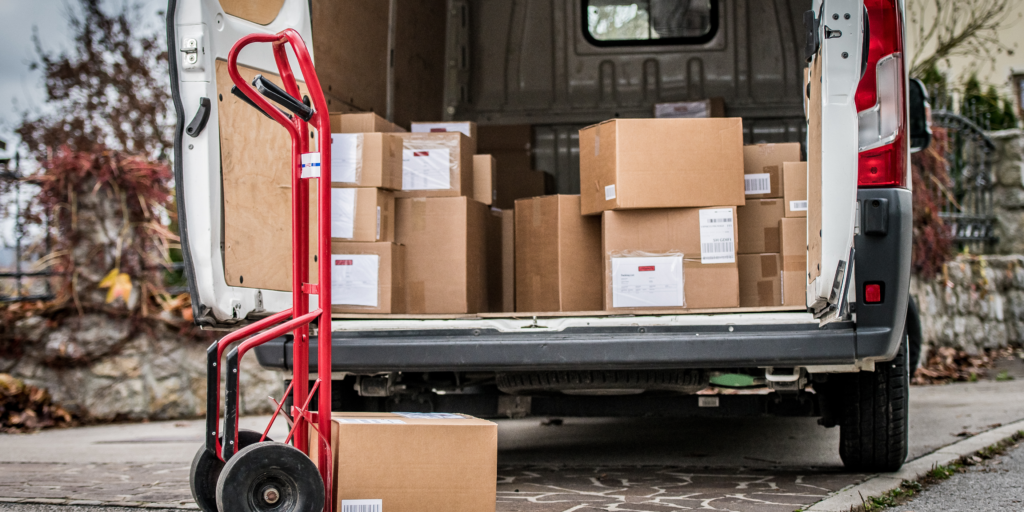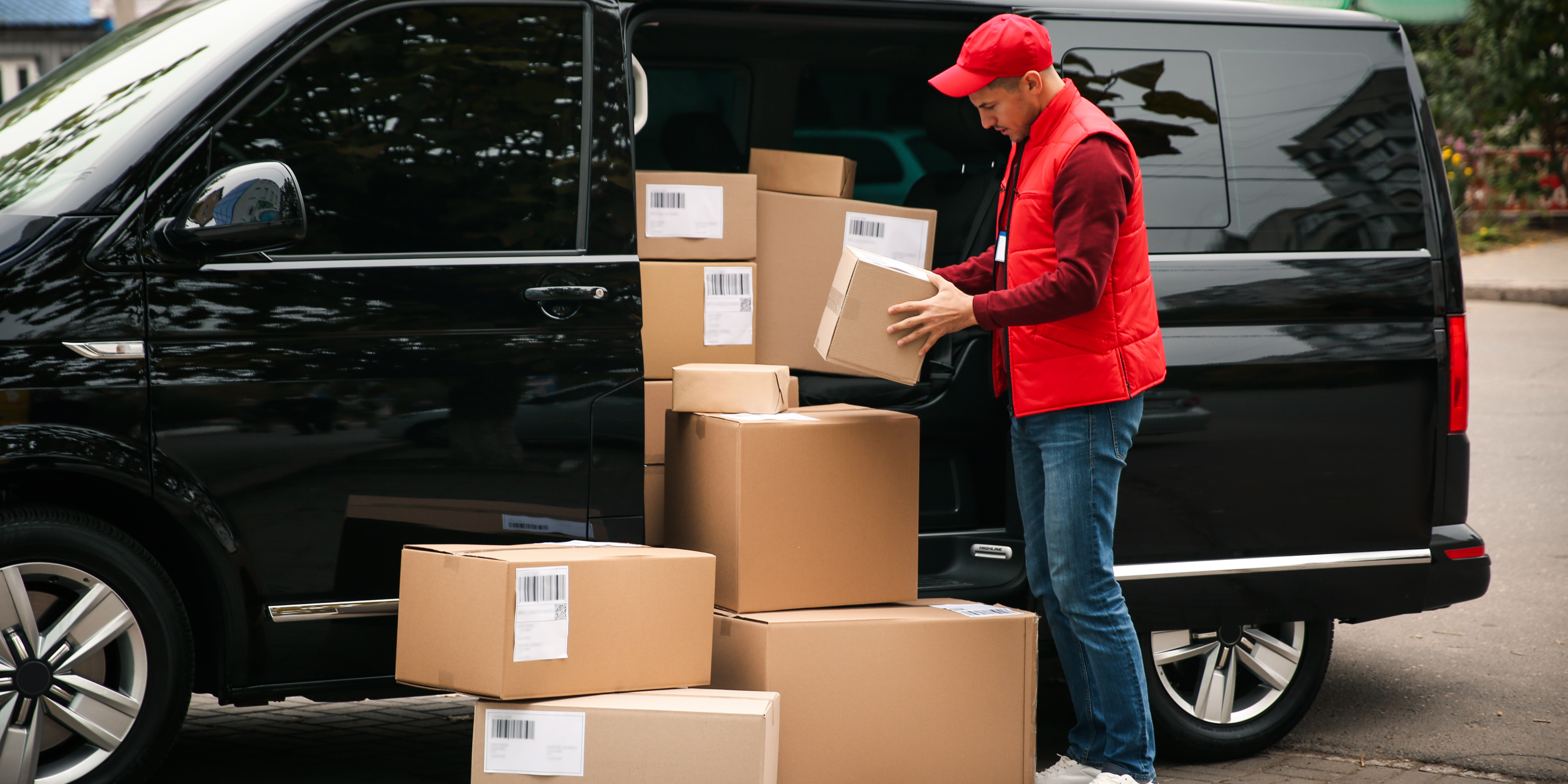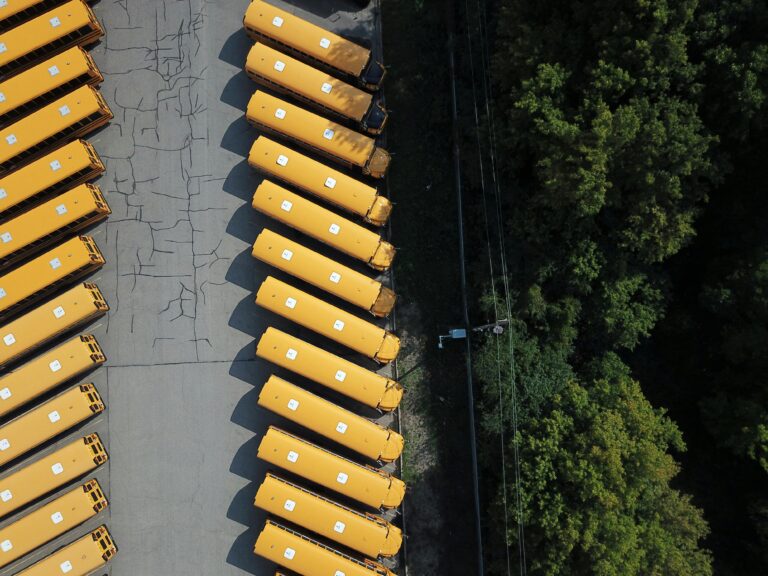Courier insurance protects the vehicle, driver, and business operations. Goods in transit insurance specifically covers the cargo being transported.
Navigating the world of business insurance can be overwhelming, especially when terms seem so similar! Did you know that 67% of delivery businesses are underinsured because they don’t understand the difference between courier insurance and goods in transit insurance? This comprehensive guide breaks down these two essential types of coverage that protect delivery businesses in different but complementary ways. Whether you’re a solo courier or managing a fleet, understanding these distinctions is crucial for proper protection and compliance with industry regulations.

What is Courier Insurance?
Courier insurance is a specialised form of commercial vehicle insurance designed specifically for individuals and businesses that deliver goods to multiple destinations. Unlike standard vehicle insurance, courier insurance provides comprehensive coverage for the unique risks associated with the delivery industry. This type of insurance primarily focuses on protecting the courier’s vehicle, the driver, and the overall business operations rather than the items being transported.
When you operate a courier business, you’re exposed to significantly higher risks than regular drivers. Your vehicles are on the road for longer periods, often visiting multiple locations daily, navigating unfamiliar areas, and making frequent stops. Courier insurance accounts for these increased risks by offering tailored protection that standard policies simply don’t provide.
Most courier insurance policies include several key components that work together to provide comprehensive protection. These typically include public liability coverage, which protects you if you cause injury or damage to third parties or their property during your delivery activities. Employer’s liability is another crucial component if you employ other drivers, as it’s legally required and covers claims made by employees who suffer injury or illness due to their work.
The core of courier insurance is the vehicle coverage itself, which protects against damage, theft, and accidents. Many policies also include breakdown assistance, which is particularly valuable for courier businesses where vehicle downtime directly impacts revenue. Some comprehensive policies may even offer personal accident cover for drivers, providing financial protection in case of serious injury or disability resulting from an accident.
🔑 Key Takeaway: It’s important to note that courier insurance is a legal requirement for operating a delivery business. Attempting to use a standard personal or even commercial vehicle policy for courier activities often invalidates your insurance, leaving you personally liable for damages and potentially facing legal penalties for operating without proper cover.
| Coverage Component | What It Protects | Typically Included? |
|---|---|---|
| Vehicle Coverage | Your delivery vehicles against damage, theft, and accidents | Yes (Core coverage) |
| Public Liability | Protection if you cause injury or damage to third parties | Yes |
| Employer’s Liability | Legal requirement if you employ other drivers | Yes (if you have employees) |
| Breakdown Assistance | Help when your vehicle breaks down during deliveries | Often included or optional |
| Personal Accident | Financial protection for drivers in case of injury | Sometimes included or optional |
| Legal Expenses | Coverage for legal costs related to insurance claims | Sometimes included or optional |
The cost of courier insurance varies based on several factors, including your driving history, the type and number of vehicles in your fleet, your annual mileage, the areas you operate in, and the value of goods typically transported. Many insurers offer specialised courier insurance packages for different business sizes, from individual self-employed couriers to large delivery fleets with multiple drivers.
When selecting courier insurance, it’s crucial to accurately disclose the nature of your business activities, as failing to do so could result in denied claims when you need coverage most. Additionally, most policies require you to maintain certain security standards for your vehicles and follow specific procedures when making deliveries to ensure your cover remains valid.

What is Goods in Transit Insurance?
Goods in transit insurance is a specialised type of coverage designed to protect the cargo being transported from point A to point B, regardless of the method of transportation. Unlike courier insurance, which focuses on the vehicle and driver, goods in transit insurance specifically addresses the financial risks associated with the items being moved. This insurance provides crucial protection for businesses that transport goods, ensuring that the value of the cargo is safeguarded against potential loss, damage, or theft during transit.
The fundamental purpose of goods in transit insurance is to compensate business owners for the financial loss that occurs if goods are damaged, lost, or stolen while being transported. This coverage extends beyond traditional shipping insurance, offering protection across various modes of transportation including road, rail, air, and sea. Whether you’re a small business shipping occasional packages or a large logistics company moving multiple consignments daily, goods in transit insurance provides a critical safety net that protects your financial interests.
Typically, goods in transit insurance covers a wide range of potential risks that can occur during transportation. These include accidents that might damage goods, theft, natural disasters, loading and unloading incidents, and even some cases of improper handling. The scope of coverage can vary significantly between policies, with some offering comprehensive “all risks” protection, while others may have more specific limitations on what types of damage or loss are covered.
| Type of Coverage | What It Protects | Typical Scenarios Covered |
|---|---|---|
| Theft Protection | Cargo stolen during transit | Vehicle break-ins, warehouse theft, hijacking |
| Damage Coverage | Goods damaged during transportation | Accidents, improper handling, environmental damage |
| Loss Protection | Items completely lost during transit | Misplacement, complete destruction, total loss |
| Loading/Unloading | Incidents during cargo movement | Damage while loading or unloading vehicles |
| Natural Disaster | Damage from environmental events | Floods, storms, earthquakes |
The value of goods in transit insurance becomes particularly evident when considering the potential financial impact of cargo loss. For many businesses, a single lost or damaged shipment can represent a significant financial blow. This insurance not only covers the direct value of the goods but often includes additional costs such as replacement, transportation, and potential loss of business. Some policies even extend to cover customs duties and other associated expenses.
Different industries require different levels of goods in transit insurance. A small e-commerce business shipping fragile electronics will have different insurance needs compared to a large manufacturing company transporting heavy machinery. Factors that influence the cost and extent of coverage include the type of goods being transported, their value, the distance travelled, the mode of transportation, and the frequency of shipments.
🔑 Key Takeaway: It’s worth noting that goods in transit insurance is not typically a legal requirement like vehicle insurance, but it is strongly recommended for businesses that rely on the transportation of goods. Many professional clients and contracts actually require suppliers to have this type of insurance as a condition of doing business. Moreover, the coverage can provide peace of mind, allowing businesses to focus on their core operations without constant worry about potential transportation-related risks.
When selecting a goods in transit insurance policy, businesses should carefully review the specific terms, paying close attention to coverage limits, exclusions, and any additional conditions. Some policies offer optional extras like international coverage, high value item protection, or cover for perishable goods. The key is to find a policy that matches the specific needs of your business, providing comprehensive protection without unnecessary expense.

Key Differences Between Courier Insurance and Goods in Transit Insurance
Understanding the nuanced differences between courier insurance and goods in transit insurance is crucial for businesses seeking comprehensive protection. While both types of insurance are related to transportation and delivery, they serve distinctly different purposes and protect different aspects of a business’s operations.
The primary distinction lies in their focus: courier insurance protects the vehicle, driver, and business operations, whereas goods in transit insurance specifically covers the cargo being transported.
| Courier Insurance | Goods in Transit Insurance | |
|---|---|---|
| Primary Focus | Vehicle and driver protection | Cargo protection |
| Legal Requirement | Often mandatory for commercial vehicles | Generally optional but recommended |
| Coverage Scope | Business operations and vehicle related risks | Specific protection for transported goods |
| Risk Protection | Driver liability, vehicle damage, business operations | Cargo theft, damage, loss during transportation |
| Typical Claimants | Courier company or driver | Cargo owner or business shipping goods |
The legal and regulatory landscape further distinguishes these two types of insurance. Courier insurance is typically a legal requirement for businesses operating commercial vehicles, with strict compliance standards that must be met to legally operate a delivery service. In contrast, goods in transit insurance remains optional, albeit strongly recommended for businesses that regularly transport valuable or sensitive items.
Cost structures and premium calculations for these insurance types differ significantly. Courier insurance premiums are primarily calculated based on factors such as the number and type of vehicles, driver histories, business location, and annual mileage. Goods in transit insurance, however, determines premiums based on the value of goods transported, their nature, transportation routes, and the frequency of shipments.
The claim processes for these insurances also vary substantially. A courier insurance claim might involve vehicle repairs, driver medical expenses, or liability protection for accidents during delivery. Goods in transit insurance claims focus specifically on the value of lost, damaged, or stolen cargo, often requiring detailed documentation of the goods’ condition before and after transportation.
Another critical difference lies in the breadth of protection. Courier insurance provides a comprehensive shield for the entire delivery operation, including potential third-party liability, vehicle maintenance, and driver protection. Goods in transit insurance, by design, is narrowly focused on the financial protection of the specific items being moved, regardless of the transportation method or vehicle used.
Business size and operational complexity also influence the need for these insurance types. Small independent couriers might prioritise courier insurance to meet legal requirements and protect their primary business asset, their vehicle. Larger logistics companies or businesses frequently shipping valuable items might invest more heavily in goods in transit insurance to mitigate potential financial losses from cargo damage or loss.
💡 Pro Tip: It’s important to recognise that these insurance types are not mutually exclusive. Many businesses benefit from having both courier insurance and goods in transit insurance, creating a comprehensive protection strategy. This approach ensures that both the business operations and the valuable cargo are fully safeguarded against potential risks during transportation.
The choice between these insurance types or the decision to invest in both depends on multiple factors including business model, cargo type, transportation frequency, and specific risk exposure. Professional insurance advisors can help businesses conduct a thorough risk assessment to determine the most appropriate insurance cover strategy that balances protection and cost effectiveness.

When Do You Need Both Types of Insurance?
For many businesses involved in delivery and transportation, the question isn’t whether to choose courier insurance or goods in transit insurance, but rather understanding when both types of coverage are necessary. While each insurance type serves a distinct purpose, there are numerous scenarios where having both policies creates a comprehensive protection strategy that safeguards all aspects of your delivery operations.
Businesses that both own delivery vehicles and transport valuable goods for clients typically benefit most from combined coverage.
Consider a small courier company with a fleet of five vans delivering high value electronics to retailers. The courier insurance protects the vehicles and drivers during operations, while goods in transit insurance covers the expensive electronics being transported. Without either policy, the business would face significant exposure to financial risk.
| Business Type | Why Courier Insurance Needed | Why Goods in Transit Insurance Needed |
|---|---|---|
| E-commerce Retailers | Protects delivery vehicles and drivers making customer deliveries | Covers products being shipped to customers against damage or loss |
| Independent Couriers | Legal requirement for commercial driving; vehicle protection | Protects client goods during transport, enhancing service offering |
| Logistics Companies | Comprehensive fleet protection; employee liability coverage | Protection for varying cargo types and values across multiple clients |
| Specialised Transport Services | Coverage for specialised vehicles (refrigerated, secure) | Protection for high value or sensitive cargo (medical supplies, artwork) |
| Last Mile Delivery Services | Protection for frequent stops and urban driving risks | Coverage for diverse package types from multiple vendors |
The value and nature of transported goods often dictate the necessity for both insurance types. Businesses regularly handling high value items such as electronics, jewellery, artwork, or specialised equipment face substantial financial risk if these items are damaged or lost during transport. While courier insurance protects the vehicle and driver, it typically excludes or severely limits coverage for the cargo itself. Only goods in transit insurance provides adequate protection for these valuable items.
The frequency of deliveries and geographical scope of operations also influence the need for both insurances. Businesses making multiple deliveries daily across extended geographical areas face increased exposure to both vehicle related incidents and cargo risks. The probability of encountering adverse weather, traffic accidents, or theft increases with more frequent deliveries and wider operational areas, making comprehensive cover increasingly important.
Client requirements and contractual obligations often necessitate both insurance types. Many corporate clients, government agencies, and retail partners require their suppliers and delivery partners to maintain comprehensive insurance cover as a condition of doing business. These requirements frequently specify both vehicle/liability coverage (courier insurance) and cargo protection (goods in transit insurance), making both insurances essential for securing and maintaining valuable contracts.
Business growth and scalability considerations should also factor into insurance decisions. As delivery operations expand, risk exposure increases proportionally. A business might start with basic courier insurance but find that adding goods in transit coverage becomes essential as they begin handling more valuable cargo or serving more demanding clients. Having both insurance types in place creates a scalable protection framework that can accommodate business growth.
🔑 Key Takeaway: Case studies clearly demonstrate the value of combined coverage. Consider a delivery company that experienced a vehicle theft while transporting £50,000 worth of computer equipment. The courier insurance covered the stolen vehicle and related business interruption, while the goods in transit policy covered the full value of the stolen cargo. Without both policies, the company would have faced a devastating financial loss that might have threatened its survival.
The cost benefit analysis typically favours both insurance policies for most delivery businesses. While maintaining two insurance policies increases overall insurance expenses, the comprehensive protection provided often represents excellent value when compared to the potential financial impact of an uninsured loss. Some insurers also offer an optional policy that provides both types of cover at more competitive rates than purchasing separate policies.

How to Choose the Right Insurance for Your Courier Business
Selecting the right insurance coverage for your courier business requires careful consideration of multiple factors specific to your operations. The process begins with a thorough assessment of your business model, including the types of items you transport, the vehicles you use, your delivery frequency, and your geographical coverage area. This evaluation forms the foundation for determining your insurance needs and ensures that you secure coverage that addresses your specific risk profile.
Understanding your exposure to different types of risk is crucial for making informed insurance decisions. Consider the potential financial impact of various scenarios: vehicle accidents, cargo theft, damage during loading and unloading, and liability claims from third parties. Quantifying these risks helps prioritise your insurance needs and allocate your budget effectively.
| Risk Assessment Categories | Questions to Consider | Insurance Implications |
|---|---|---|
| Vehicle Operations | How many vehicles? What types? Annual mileage? Urban or rural routes? | Affects courier insurance requirements and premiums |
| Cargo Profile | Average and maximum value? Fragile items? Hazardous materials? | Determines goods in transit coverage needs |
| Business Scale | Number of employees? Annual revenue? Growth projections? | Influences comprehensive coverage requirements |
| Client Requirements | Do contracts specify insurance minimums? Specific coverage types? | May necessitate particular policy features |
| Delivery Patterns | Frequency of deliveries? Peak seasons? International shipments? | Impacts coverage scope and flexibility needs |
When comparing insurance providers, look beyond basic premium costs to evaluate their industry expertise and claims handling reputation. Brokers and Insurers with specific experience in the courier and logistics sector often provide more tailored coverage and better understand the unique challenges faced by delivery businesses. Research potential providers through industry associations, online reviews, and recommendations from other courier businesses.
Pay close attention to policy details, as coverage can vary significantly between insurers. Examine coverage limits, deductibles, exclusions, and specific conditions that might affect your ability to make claims. For courier insurance, verify that the policy covers all vehicles in your fleet and all drivers, including temporary or seasonal staff. For goods in transit insurance, ensure that coverage extends to all types of cargo you handle and includes protection during loading, unloading, and temporary storage.
Consider how your business might evolve over time and choose policies that can adapt to your changing needs. If you anticipate expanding your delivery area, adding vehicles, or transporting different types of goods, discuss these plans with potential insurers to ensure your cover can grow with your business. Some insurers offer flexible policies that can be adjusted as your operations change, preventing coverage gaps during periods of business growth.
Cost management is a critical aspect of insurance selection, but it shouldn’t be the sole determining factor. While it’s important to find affordable coverage, choosing policies based solely on low premiums can lead to inadequate protection. Instead, focus on value, the balance between comprehensive coverage and reasonable cost. Consider options like higher deductibles to lower premiums, but ensure that you can comfortably afford the deductible amount in the event of a claim.
Having different types of insurance with the same broker or insurance provider can often result in cost savings and simplified administration. Many insurers offer package deals that combine courier insurance, goods in transit coverage, and other business protections like public liability and commercial property insurance. These comprehensive packages can provide broader protection at a lower overall cost than purchasing separate policies from different providers.
The claims process is another important consideration when selecting insurance. Investigate how potential insurers handle claims, their responsiveness, documentation requirements, and typical settlement timeframes. A provider with a streamlined, efficient claims process can significantly reduce business disruption following an incident, allowing you to focus on maintaining your delivery operations.
💡 Pro Tip: Regular policy reviews with your commercial broker should be part of your long term insurance strategy. As your business evolves, your insurance needs will change. Schedule annual reviews with your insurance provider to ensure your coverage remains appropriate for your operations. This proactive approach helps prevent coverage gaps and ensures you’re not paying for unnecessary protection that no longer aligns with your business activities.

Common Misconceptions About Courier and Goods in Transit Insurance
The insurance landscape for delivery businesses is fraught with misconceptions that can lead to significant gaps in cover and financial vulnerability.
The most pervasive myth is that standard vehicle insurance provides adequate protection for courier activities. Many new courier businesses operate under the dangerous assumption that their personal or standard commercial vehicle insurance will cover them while making deliveries. In reality, using a vehicle for courier purposes without specialised courier insurance typically invalidates standard policies, leaving drivers completely unprotected in the event of an accident. Insurers specifically exclude “hire and reward” activities (transporting goods for payment) from standard policies, creating a critical coverage gap for unsuspecting couriers.
Another common misunderstanding revolves around the scope of goods in transit insurance. Many business owners incorrectly believe this insurance automatically covers all items during transportation, regardless of value or type. In practice, goods in transit policies often contain significant limitations regarding high-value items, perishable goods, or specialized cargo like hazardous materials. Without carefully reviewing policy details, businesses may discover too late that certain shipments fall outside their coverage parameters.
The term “all risks” in goods in transit insurance creates particular confusion. Despite its comprehensive sounding name, “all-risks” policies still contain numerous exclusions that vary between insurers. Many business owners mistakenly interpret this terminology to mean absolute protection against every possible scenario, only to discover significant gaps when making claims. Common exclusions include damage due to improper packaging, inherent vice (deterioration due to the nature of the item itself), and losses occurring during specific high risk activities.
| Misconception | Reality | Potential Consequences |
|---|---|---|
| Standard vehicle insurance covers courier activities | Standard policies exclude “hire and reward” activities | Claims denial; personal liability for accidents |
| Personal items in delivery vehicles are covered | Personal belongings typically excluded from courier insurance | Uninsured losses of driver’s personal property |
| “All-risks” goods in transit insurance covers everything | Significant exclusions still apply to “all-risks” policies | Unexpected claim denials for certain types of damage |
| International deliveries are automatically covered | Most basic policies limit coverage to domestic transportation | Uninsured losses during international shipments |
| Insurance covers the full retail value of goods | Many policies cover wholesale or cost price only | Under compensation for lost or damaged goods |
| One insurance type is sufficient for all courier businesses | Different business models require tailored coverage combinations | Significant coverage gaps and financial exposure |
The geographical scope of insurance cover generates substantial confusion, particularly regarding international deliveries. Many courier businesses assume their domestic insurance policies automatically extend to international shipments, when in fact most standard policies are strictly limited to the country of issue. International coverage typically requires specific policy extensions or entirely separate insurance products, potentially leaving businesses with completely unprotected cargo when crossing borders.
Misunderstandings about claim limits and excess amounts frequently lead to financial surprises. Many businesses focus solely on the maximum coverage amount without considering how their excess (deductible) applies to each claim. Some goods in transit policies apply the excess per item rather than per shipment, dramatically increasing out of pocket costs for claims involving multiple damaged items. Similarly, courier insurance may have different excess levels for different types of claims (theft, accidental damage, windscreen, etc.), creating confusion about actual financial exposure.
The relationship between different insurance types often causes confusion. Some business owners incorrectly believe that having robust courier insurance eliminates the need for goods in transit cover, or vice versa. This misunderstanding stems from not recognising the fundamentally different focuses of these policies. One protects the vehicle and business operations, the other protecting the cargo itself. This misconception often leaves businesses with critical protection gaps that become apparent only after a significant loss.
Equally problematic is the belief that insurance costs are fixed and non negotiable. Many courier businesses fail to recognise that premiums can be significantly influenced by implementing enhanced security measures, driver training programs, or more sophisticated tracking systems. Without understanding these factors, businesses may pay unnecessarily high premiums while missing opportunities to simultaneously improve operations and reduce insurance costs.
The timing of insurance activation represents another area of confusion. Some businesses mistakenly believe cover begins immediately upon making a payment, when many policies include waiting periods before certain coverages take effect. Others fail to understand the implications of retroactive dates in claims made policies, potentially leaving historical incidents uninsured despite having current coverage in place.
💡 Pro Tip: All the above misconceptions highlight the importance of working with insurance professionals who specialise in the transportation and logistics sector. Expert guidance can help navigate the complexities of courier and goods in transit insurance, ensuring your cover aligns with actual business needs and risks rather than being based on common but dangerous assumptions.
Choosing between courier insurance and goods in transit insurance shouldn’t be an either/or decision for most delivery businesses. While courier insurance protects your vehicles, drivers, and business operations, goods in transit insurance specifically safeguards the customer’s items you’re transporting. For comprehensive protection, most courier businesses benefit from having both types of coverage tailored to their specific operations. Take time to assess your business needs, compare policies from reputable providers, and ensure you’re properly covered against all potential risks. Your business’s reputation and financial security depend on making informed insurance choices!
This guide is intended for informational purposes only and does not constitute legal or insurance advice. Always consult with your insurance provider or legal professional for specific guidance regarding your policy.
Need to Speak?
If you can’t find the answer to your question and need to discuss with an agent who can help answer and possibly look to place you with the relevant insurer to suit your business needs, click below for an immediate call back







